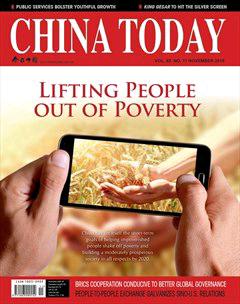Sci-Tech
Sci-Tech
China Launches Manned Spacecraft

On October 17, China launched the Shenzhou XI manned spacecraft carrying two astronauts to the Tiangong II space lab.
The spacecraft blasted off at 7:30 am from the Jiuquan Satellite Launch Center in Northwest China, on a Long March 2F rocket. The two male astronauts are 49-year-old Jing Haipeng and 37-year-old Chen Dong.
After travelling for two days the spacecraft docked with the Tiangong II, which was launched from the Jiuquan center in mid-September. The astronauts then entered the space lab and will stay there for 33 days – the longest mission so far in the country’s space program.
The core tasks of the Shenzhou XI mission are to test rendezvous and docking technologies for the country’s planned space station, verify the life-support capability of the combined spacecraft-space lab, and conduct scientific research and in-orbit maintenance, according to Wu Ping, deputy director of the China Manned Space Agency.
Prior to the Shenzhou XI, China has sent five spacecraft and 10 astronauts into space since 2003, notably Shenzhou V launched in 2011, carrying the nation’s first astronaut Yang Liwei, now a senior space official, into space.
China is the third country in the world, after the former Soviet Union and the United States, to independently carry out a successful manned spaceflight.
China’s manned space program, a great source of national pride, aims to put a permanent manned space station into service around 2022, according to the manned space agency. The station will comprise three parts: a core module attached to two labs, each weighing about 20 metric tons.
World’s Largest Radio Telescope Begins Operation

The world’s largest radio telescope was put into use on September 25 in a mountainous region of southwest China’s Guizhou Province.
In a karst valley in Pingtang County hundreds of astronomers and astronomy enthusiasts witnessed the official launch of the 500-meter Aperture Spherical Telescope’s (FAST) mission to explore space and hunt for extraterrestrial life.
Work on the RMB 1.2 billion project started in 2011, 17 years after it was proposed by Chinese astronomers.
The installation of the telescope’s main structure – a 4,450-panel reflector equal in size to 30 football pitches – was finished in early July.
“(The telescope) will certainly generate enthusiasm, bring people into science, and make China important in the world of science,” said Joseph Taylor, a Nobel Prizewinning astronomer at Princeton University. .
In fact, FAST has got off to a good start. In a recent trial observation, it received a set of high-quality electromagnetic waves sent from a pulsar about 1,351 light-years away, said Qian Lei, an associate researcher with the National Astronomical Observation (NAO) under the Chinese Academy of Sciences, which built the project. FAST’s tasks include observation of pulsars as well as exploration of interstellar molecules and interstellar communication signals.
The telescope’s leading engineer, Wang Qiming said that the telescope, designed and built by Chinese scientists, will remain the global leader for the next 10 to 20 years. Yan Jun, head of the NAO, said China will roll out more “world-class” telescope projects in five to 10 years.
China’s First Suspension Railway Completes Test Run

China’s first suspension railway line – an elevated monorail where the train is suspended from a fixed track – finished its test run in Chengdu, capital of southwest China’s Sichuan Province, on September 30.
China owns complete proprietary intellectual property rights over related technologies, which are a major innovation in China’s rail transit, chief designer of the project Zhai Wanming of Southwest Jiaotong University said.
After being suspended from the railway line the lithium-battery powered train, which has a speed of 60 km per hour, successfully ran along its 300-meter test section. The load capacity will be 120 passengers per train coach, according to Zhai. The test section of the railway line will be expanded to 1.25 kilometers for further tests on turning, climbing, and operations at train and charging stations, Zhai said.
The environmentally-friendly, low-cost transit system, with its large windows and the aerial view it provides of the urban landscape, offers a fresh option for urban public transportation, Zhai concluded.
Chinese and American Scientists Invent Power-generating Fabric
Playing games on a sunny afternoon may soon be a way to charge your smart devices, thanks to a new fabric developed by Chinese and American scientists.
The fabric harvests energy from both motion and sunlight. Solar cells and nano-generators embedded in lightweight fibers are interwoven with wool to create the fabric, according to Fan Xing, chemical engineering professor at Chongqing University. The findings, in cooperation with the Georgia Institute of Technology, were published in the international academic journal Nature Energy last September.
Just 0.32 millimeters thick, the fabric could be used for wearable devices or as window shades and tents in the future, Fan said.
With sufficient sunlight and constant motion, a 5-cm long, 4-cm wide fabric can generate and maintain a voltage level of 5V, enough to charge a cellphone.
“Our research takes into full account the safety of the fabric, which is why we conduct our tests at low voltage,” Fan said. “The fabric is consequently harmless to the human body.”
Durability tests have not yet been run, but after 500 curling experiments it showed no decline in performance.

